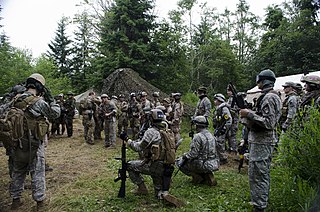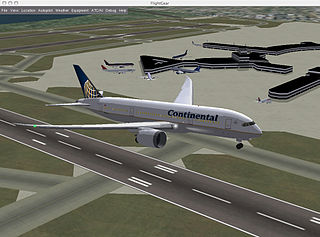
A simulation is the imitation of the operation of a real-world process or system over time. Simulations require the use of models; the model represents the key characteristics or behaviors of the selected system or process, whereas the simulation represents the evolution of the model over time. Often, computers are used to execute the simulation.

Operation Flashpoint: Cold War Crisis is a tactical shooter and battlefield simulator video game developed by Bohemia Interactive Studio and published by Codemasters in 2001. In 2011, Bohemia Interactive re-released the game under the title ARMA: Cold War Assault. The game uses objectives and weaponry appropriate to the Cold War, the period of geopolitical tension between the United States and the Soviet Union that lasted from 1947 to 1991.

Microsoft Flight Simulator is a series of amateur flight simulator programs for Microsoft Windows operating systems, and earlier for MS-DOS and Classic Mac OS. It is one of the longest-running, best-known, and most comprehensive home flight simulator programs on the market. It was an early product in the Microsoft application portfolio and differed significantly from Microsoft's other software, which was largely business-oriented. At 38 years old, it is the longest-running software product line for Microsoft, predating Windows by three years. Microsoft Flight Simulator is one of the longest-running PC video game series of all time.
A simulation video game describes a diverse super-category of video games, generally designed to closely simulate real world activities.
A virtual airline (VA) is a dedicated hobby organization that uses flight simulation to model the operations of an airline. Virtual airlines generally have a presence on the Internet, similar to a real airline. Many hundreds of virtual airlines of significance are currently active, with tens of thousands of participants involved at any one time.
The following outline is provided as an overview of and topical guide to video games:
Combat flight simulators are vehicle simulation games, amateur flight simulation computer programs used to simulate military aircraft and their operations. These are distinct from dedicated flight simulators used for professional pilot and military flight training which consist of realistic physical recreations of the actual aircraft cockpit, often with a full-motion platform.

Team Apache is an attack helicopter flight simulator developed by Simis and published by Mindscape Group. The game emphasises on commanding a group of six AH-64 Apache crews of the US Army in battles against the Communist FARC insurgents in Colombia and the Russian military in Latvia.
Real-time tactics or RTT is a subgenre of tactical wargames played in real-time simulating the considerations and circumstances of operational warfare and military tactics. It is differentiated from real-time strategy gameplay by the lack of classic resource micromanagement and base or unit building, as well as the greater importance of individual units and a focus on complex battlefield tactics.
Microsoft Flight Simulator began as a set of articles on computer graphics, written by Bruce Artwick throughout 1976, about flight simulation using 3-D graphics. When the editor of the magazine told Artwick that subscribers were interested in purchasing such a program, Artwick founded Sublogic Corporation to commercialize his ideas. At first the new company sold flight simulators through mail order, but that changed in January 1979 with the release of Flight Simulator (FS) for the Apple II. They soon followed this up with versions for other systems and from there it evolved into a long-running series of computer flight simulators.
Life simulation games form a subgenre of simulation video games in which the player lives or controls one or more virtual characters. Such a game can revolve around "individuals and relationships, or it could be a simulation of an ecosystem". Other terms include artificial life game and simulated life game (SLG).
Wings of Power WWII Heavy Bombers and Jets is a video game of the flight simulation genre released in 2004 as an add on to enhance Microsoft Flight Simulator 2004.Wings of Power adds vintage historical military aircraft to Microsoft Flight Simulator 2004.Wings of Power also adds 50 missions with some historical missions from real military pilot logs from World War II and adds new special effects to Microsoft's flight simulator series.

MilSim, an abbreviation of military simulation, refers to live-acted simulation of armed conflict scenarios conducted by civilians for entertainment, sporting or nostalgic purposes. It has been described as both a form of "extreme sport" and as historical reenactment.

Immersion into virtual reality (VR) is a perception of being physically present in a non-physical world. The perception is created by surrounding the user of the VR system in images, sound or other stimuli that provide an engrossing total environment.
Vehicle simulation games are a genre of video games which attempt to provide the player with a realistic interpretation of operating various kinds of vehicles. This includes automobiles, aircraft, watercraft, spacecraft, military vehicles, and a variety of other vehicles. The main challenge is to master driving and steering the vehicle from the perspective of the pilot or driver, with most games adding another challenge such as racing or fighting rival vehicles. Games are often divided based on realism, with some games including more realistic physics and challenges such as fuel management.

Amateur flight simulation refers to the simulation of various aspects of flight or the flight environment for purposes other than flight training or aircraft development. A significant community of simulation enthusiasts is supported by several commercial software packages, as well as commercial and homebuilt hardware. Open-source software that is used by the Aerospace industry like FlightGear, whose flight dynamics engine (JSBSim) is used in a 2015 NASA benchmark to judge new simulation code to space industry standards, is also available for amateur use. A popular type of amateur flight simulators are combat flight simulators, which simulate combat air operations from the pilot and crew's point of view. Combat flight simulation titles are more numerous than civilian flight simulators due to variety of subject matter available and market demand.
CS Group initially named CS Communication & Systèmes is a French information-technology service company listed on the Paris Bourse as a member of the CAC Small index. The company designs information systems, develops and integrates software; manages projects and deploys industrial applications and provides science, technology and consulting services. CS Group is the French leader in air traffic control, the third biggest supplier of traffic-management systems in the world and provides information technology consulting services.
Pointman is a seated user interface for controlling one's avatar in a 3D virtual environment. It combines head tracking, a gamepad, and sliding foot pedals to provide positional control over many aspects of the avatar's posture. Pointman was developed by the US Naval Research Laboratory (NRL) to support the use of dismounted infantry simulation for USMC training and mission rehearsal. NRL's goal in developing Pointman was to extend the range and precision of actions supported by virtual simulators, to better represent what infantrymen can do.
Unmanned aircraft system simulation focuses on training pilots to control an unmanned aircraft or its payload from a control station. Flight simulation involves a device that artificially re-creates aircraft flight and the environment in which it flies for pilot training, design, or other purposes. It includes replicating the equations that govern how aircraft fly, how they react to applications of flight controls, the effects of other aircraft systems, and how the aircraft reacts to external factors such as air density, turbulence, wind shear, cloud, precipitation, etc.
A virtual reality simulator is the equipment that is used for human immersion in virtual reality with the purpose of entertainment of the public. A virtual amusement in the strict sense can not be considered a computer with a virtual reality glasses (helmet) and game content. Attractions of virtual reality besides hardware and software use the additional means to enhance the immersion effect, for example, water spray, the effect of wind, vibration, physical motion etc. The same technique was used in the X-d cinema, but there are two significant differences between them and simulators of virtual reality:







